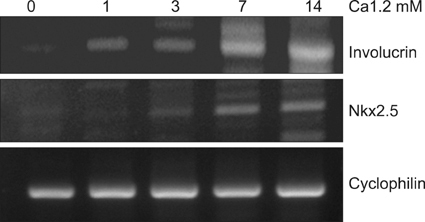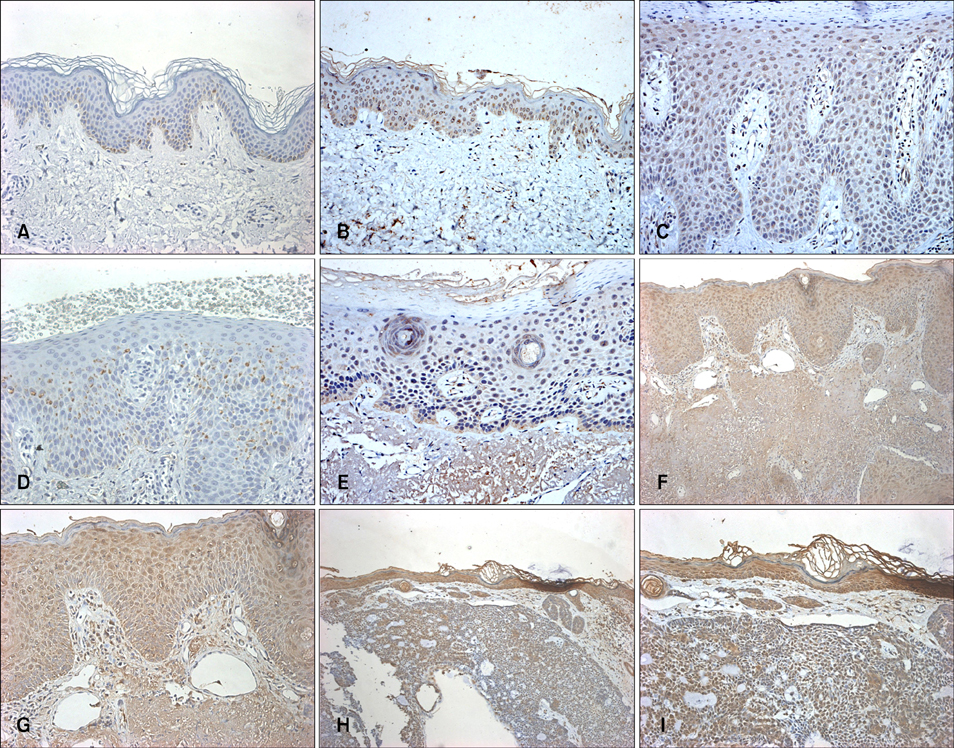The Role of Nkx2.5 in Keratinocyte Differentiation
- Affiliations
-
- 1Department of Dermatology, College of Medicine, Chungnam National University, Daejeon, Korea. jhoon@cnu.ac.kr
- 2Skin Research Institute, Amorepacific R&D Center, Yongin, Korea.
- 3Lee Joong Hwa Urologic Clinic, Daejeon, Korea.
- KMID: 2156500
- DOI: http://doi.org/10.5021/ad.2009.21.4.376
Abstract
- BACKGROUND
Nkx2.5 is a homeodomain-containing nuclear transcription protein that has been associated with acute T-lymphoblastic leukemia. In addition, Nkx2.5 has an essential role in cardiomyogenesis. However, the expression of Nkx2.5 in the skin has not been investigated.
OBJECTIVE
In an attempt to screen the differentially regulated genes involved in keratinocyte differentiation, using a cDNA microarray, we identified Nkx2.5 as one of the transcription factors controlling the expression of proteins associated with keratinocyte differentiation.
METHODS
To investigate the expression of Nkx2.5 during keratinocyte differentiation, we used a calcium-induced keratinocyte differentiation model.
RESULTS
RT-PCR and Western blot analysis revealed that the expression of Nkx2.5, in cultured human epidermal keratinocytes, increased with calcium treatment in a time-dependent manner. In normal skin tissue, the expression of Nkx2.5 was detected in the nuclei of the keratinocytes in all layers of the epidermis except the basal layer by immunohistochemistry. In addition, the expression of Nkx2.5 was significantly increased in psoriasis and squamous cell carcinoma, but was barely detected in atopic dermatitis and basal cell carcinoma.
CONCLUSION
These results suggest that Nkx2.5 may play a role in the change from proliferation to differentiation of keratinocytes and in the pathogenesis of skin disease with aberrant keratinocyte differentiation.
MeSH Terms
Figure
Cited by 3 articles
-
Enhancement of Keratinocyte Differentiation by Rose Absolute Oil
Jin-Hwa Kim, Dae-Kyoung Choi, Sang-Sin Lee, Sun Ja Choi, Chang Deok Kim, Tae-Jin Yoon, Jeung-Hoon Lee
Ann Dermatol. 2010;22(3):255-261. doi: 10.5021/ad.2010.22.3.255.Epigenetic Modulation of Gene Expression during Keratinocyte Differentiation
Seung Ju Back, Myung Im, Kyung Cheol Sohn, Dae Kyoung Choi, Ge Shi, Nam Ji Jeong, Young Lee, Young Joon Seo, Chang Deok Kim, Jeung Hoon Lee
Ann Dermatol. 2012;24(3):261-266. doi: 10.5021/ad.2012.24.3.261.Comparison of Gene Expression Profiles between Keratinocytes, Melanocytes and Fibroblasts
Jung-Suk Lee, Dae-Hun Kim, Dae-Kyoung Choi, Chang Deok Kim, Gwang-Bum Ahn, Tae Young Yoon, Jeung-Hoon Lee, Ji Yeoun Lee
Ann Dermatol. 2013;25(1):36-45. doi: 10.5021/ad.2013.25.1.36.
Reference
-
1. Kalinin AE, Kajava AV, Steinert PM. Epithelial barrier function: assembly and structural features of the cornified cell envelope. Bioessays. 2002. 24:789–800.
Article2. Rice RH, Green H. The cornified envelope of terminally differentiated human epidermal keratinocytes consists of cross-linked protein. Cell. 1977. 11:417–422.
Article3. Fuchs E. Epidermal differentiation and keratin gene expression. J Cell Sci Suppl. 1993. 17:197–208.
Article4. Steinert PM, Marekov LN. The proteins elafin, filaggrin, keratin intermediate filaments, loricrin, and small proline-rich proteins 1 and 2 are isodipeptide cross-linked components of the human epidermal cornified cell envelope. J Biol Chem. 1995. 270:17702–17711.
Article5. Steinert PM, Marekov LN. Direct evidence that involucrin is a major early isopeptide cross-linked component of the keratinocyte cornified cell envelope. J Biol Chem. 1997. 272:2021–2030.
Article6. Nemes Z, Steinert PM. Bricks and mortar of the epidermal barrier. Exp Mol Med. 1999. 31:5–19.
Article7. Harvey RP. NK-2 Homeobox genes and heart development. Dev Biol. 1996. 178:203–216.8. Ma CM. Spatial and temporal expression patterns of Xenopus Nkx-2.3 gene in skin epidermis during metamorphosis. Gene Expr Patterns. 2004. 5:129–134.
Article9. Ueyama T, Kasahara H, Ishiwata T, Nie Q, Izumo S. Myocardin expression is regulated by Nkx2.5, and its function is required for cardiomyogenesis. Mol Cell Biol. 2003. 23:9222–9232.
Article10. McElhinney DB, Geiger E, Blinder J, Benson DW, Goldmuntz E. NKX2.5 mutations in patients with congenital heart disease. J Am Coll Cardiol. 2003. 42:1650–1655.
Article11. Akazawa H, Komuro I. Cardiac transcription factor Csx/Nkx2-5: Its role in cardiac development and diseases. Pharmacol Ther. 2005. 107:252–268.
Article12. Nagel S, Scherr M, Kel A, Hornischer K, Crawford GE, Kaufmann M, et al. Activation of TLX3 and NKX2-5 in t(5;14)(q35;q32) T-cell acute lymphoblastic leukemia by remote 3'-BCL11B enhancers and coregulation by PU.1 and HMGA1. Cancer Res. 2007. 67:1461–1471.
Article13. Przybylski GK, Dik WA, Grabarczyk P, Wanzeck J, Chudobska P, Jankowski K, et al. The effect of a novel recombination between the homeobox gene NKX2-5 and the TRD locus in T-cell acute lymphoblastic leukemia on activation of the NKX2-5 gene. Haematologica. 2006. 91:317–321.14. Nagel S, Kaufmann M, Drexler HG, MacLeod RA. The cardiac homeobox gene NKX2-5 is deregulated by juxtaposition with BCL11B in pediatric T-ALL cell lines via a novel t(5;14)(q35.1;q32.2). Cancer Res. 2003. 63:5329–5334.15. Kremers HM, McEvoy MT, Dann FJ, Gabriel SE. Heart disease in psoriasis. J Am Acad Dermatol. 2007. 57:347–354.
Article16. Ludwig RJ, Herzog C, Rostock A, Ochsendorf FR, Zollner TM, Thaci D, et al. Psoriasis: a possible risk factor for development of coronary artery calcification. Br J Dermatol. 2007. 156:271–276.
Article17. Markuszeski L, Bissinger A, Janusz I, Narbutt J, Jedrzejowska AS, Zalewska A. Heart rate and arrhythmia in patients with psoriasis vulgaris. Arch Med Res. 2007. 38:64–69.
Article18. Han C, Robinson DW Jr, Hackett MV, Paramore LC, Fraeman KH, Bala MV. Cardiovascular disease and risk factors in patients with rheumatoid arthritis, psoriatic arthritis, and ankylosing spondylitis. J Rheumatol. 2006. 33:2167–2172.19. Zeeuwen PL, de Jongh GJ, Rodijk-Olthuis D, Kamsteeg M, Verhoosel RM, van Rossum MM, et al. Genetically programmed differences in epidermal host defense between psoriasis and atopic dermatitis patients. PLoS One. 2008. 3:e2301.
Article20. Cho SH, Seo SJ, Hong CK. Expression of antimicrobial peptides according to changes of transepidermal water loss levels in patients with atopic dermatitis. Ann Dermatol. 2007. 19:47–54.
Article
- Full Text Links
- Actions
-
Cited
- CITED
-
- Close
- Share
- Similar articles
-
- Studies on Differentiation of Cardiac Myoblast Induced by Co-culture with Isolated Neonatal Rat Cardiac Myocytes
- Role of Cardiac Transcription Factor Nkx2.5 on Cardiomyoplasty Model in vitro
- Single Low-Dose Radiation Induced Regulation of Keratinocyte Differentiation in Calcium-Induced HaCaT Cells
- Differential Expression of TGF-beta Isoforms During Differentiation of HaCaT Human Keratinocyte Cells: Implication for the Separate Role in Epidermal Differentiation
- Expression of Sfrp2 Is Increased in Catagen of Hair Follicles and Inhibits Keratinocyte Proliferation




